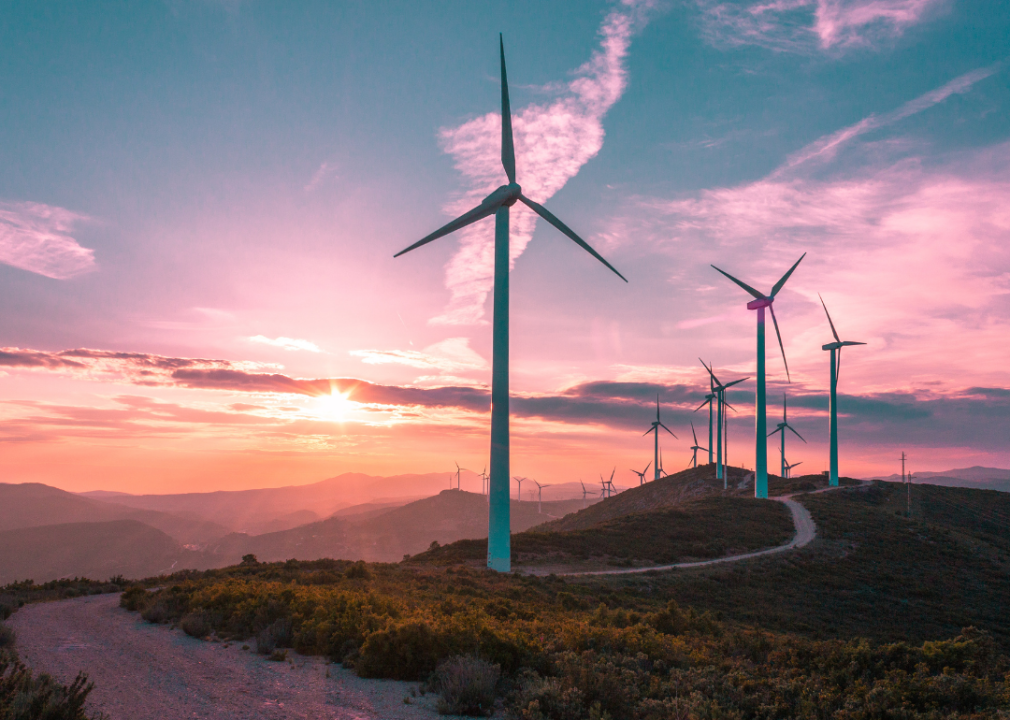How far is the US from a 100% renewable energy future?
Published 8:30 pm Friday, May 27, 2022
Space-kraft // Shutterstock
How far is the US from a 100% renewable energy future?
Renewable energy in the United States nearly quadrupled in the last decade.
Solar power production today is 23 times greater than in 2011, while wind energy has tripled. This rapid expansion can be credited to technological improvements and economies of scale. State-level policies and incentives have also played a role in subsidizing renewable infrastructure.
With production ramping up and costs coming down, Stacker outlined what 100% renewable energy could look like across the U.S. by 2050, including challenges to reaching that milestone. Data is from Stanford and projections were gleaned from The Solutions Project.
Petroleum, natural gas, and coal represented the largest sources of American energy over the last century-plus. Coal production has been in sharp decline over the last two decades, marking major progress in the country’s move toward phasing out fossil fuels. Still, the havoc being wrought by high gas prices is evidence enough of our continued reliance on dirty energy.
Roughly 61% of electricity in the U.S. was generated from fossil fuels in 2021, including coal, natural gas, petroleum, and other gasses. The U.S. is the second-largest emitter of carbon dioxide globally, with 75% coming from the energy-related burning of fossil fuels. However, the U.S. also ranks second in the world behind China for renewable energy power capacity.
Despite the plummeting prices of solar and wind, renewable energy is slow to replace fossil fuels across the country. In many cases, the cost of producing electricity using existing infrastructure is cheaper than building new renewable infrastructure. Nonetheless, more than two-thirds of Americans believe the U.S. should prioritize alternative energy sources and that steps should be taken to reach carbon neutrality by 2050. More than 30% of Americans believe fossil fuels should be phased out of the energy mix altogether.
Public opinion on renewable energy breaks along familiar political party lines, with 64% of conservatives opposing steps toward carbon neutrality by 2050 and 94% of liberals being in favor of it. Many fossil fuel workforces and economies exist in traditionally Republican regions of the country—regions that also happen to have some of the greatest wind and solar energy potential.
You may also like: How communities are dealing with invasive species across the US
![]()

Emma Rubin // Stacker
Models show the feasibility of a green-energy future
Using models to estimate future energy demand and weather prediction, Mark Jacobson, director of the Atmosphere/Energy program at Stanford, calculated how the U.S. could meet 100% renewable energy by 2050. The analysis determined what those energy demands would be in 2050 if exclusively powered by electricity, based on industry-specific breakdowns of current energy consumption and sources. Jacobsen and his team determined how renewables could meet future electric demand by combining these calculations with layers of additional data, such as wind and sun exposure, how many rooftops are shaded, and access to hydropower dams.
Wind and solar energy are broad terms that encompass many different types of products and processes to harness the power of the wind and the sun. Geography plays an important role in the strength and reliability of these resources.
There is onshore wind, like the impressive collection of turbines one might see sprawling across the plains, as well as offshore wind harnessed by turbines in bodies of water and characterized by high speeds, no obstructions, and predictable patterns.
Solar energy can be collected by residential rooftop panels, solar plants which utilize larger photovoltaic solar panels, and concentrating solar plants which use mirrors to concentrate the sun’s energy to power engines that create electricity.
Additionally, moving water can be converted into hydroelectric power. This makes up a smaller percentage of most states’ current and possible future renewable energy mix.

Emma Rubin // Stacker
Variations in potential resources determine how states would source green energy
Most states would employ a combination of wind, solar, and hydropower to meet a goal of 100% renewable energy production—but based on the region, the share of each of those will vary. States receiving more consistent sun exposure may rely more heavily on solar energy, while those in the Great Plains region with high average wind speeds may rely more on wind than states with typically stiller climates, such as those in the southeastern U.S.
In states like Alaska, where certain regions regularly go weeks without sunlight, only 6% of the potential renewable energy future would rely on solar power.

Mark Agnor // Shuttertstock
Renewable energy infrastructure could create jobs across the US
Green infrastructure creates new jobs and, in many regions, could help retain the fossil fuel workforce that renewable energy would displace.
Roughly 1.7 million Americans held jobs in the fossil fuel industry in 2019, according to a Brookings Institute analysis. Many regions where fossil fuel jobs are concentrated overlap with potential wind and solar hubs. For example, Wyoming—the country’s biggest producer of coal—is already seeing a large portion of its fossil fuel workforce attending solar and wind energy training programs.
Solar photovoltaic installers and wind turbine service technicians are among the “green” jobs expected to grow the most by 2026.

Emma Rubin // Stacker
100% renewable energy could mean major cost savings
A decade ago, it was cheaper to build a power plant that burned fossil fuels than it was to build a solar or wind farm. In 2009, the cost of electricity from solar was $359/MWh—223% more expensive than coal. Ten years later, solar prices have declined by nearly 90% to just $40/MWh and wind dropped 70% to $41/MWh, according to Lazard’s Levelized Cost of Energy Analysis as analyzed by Our World in Data.
Meanwhile, the cost of nonrenewables like coal and nuclear either increased or remained the same over the last decade. The prices of nonrenewable energy generation are determined by the cost of the fuel they’re burning (i.e. coal and petroleum) and the operating costs of the facilities themselves. In the U.S., a typical coal-fired power plant operates at roughly 33% efficiency. Energy derived from natural renewable resources does not have to be acquired or processed, keeping operational efficiency higher and costs lower.

Emma Rubin // Stacker
31 states have active renewable energy targets
Many states have enacted Renewable Portfolio Standards, which mandate that a certain percentage of electricity sold as utilities be generated by renewable resources. Other states have Clean Energy Standards, which require energy sources to produce zero carbon emissions—making them “clean” but not necessarily renewable—either in addition to or in place of an RPS.
Nuclear energy is an example of clean but nonrenewable energy. Ten states have set 100% clean or renewable energy targets by 2050 at the latest. Individual states determine which resources qualify under an RPS based on their state’s potential for renewable energy development. In Hawaii, for example, moving water from waterfalls or ocean currents qualifies as a renewable energy resource.

Emma Rubin // Stacker
Every state still relies on majority fossil fuels for energy consumption
According to the most recent EIA data, the closest state to meeting 100% renewable energy consumption is Maine, at 42% derived from renewable sources. Louisiana, which has no active renewable or clean energy goals, is the furthest from this possible future, with 3.7% of energy consumption sourced from renewable resources. Public opinion and legislative action are significant factors in a state’s renewable energy progress.

anatoliy_glebanatoliy_gleb // Shutterstock
Challenges remain in meeting 100% renewable energy by 2050
One of the most significant barriers to ramping up renewable energy production is the need to do it at scale with standardized equipment to turn a profit. The physical requirements of renewable infrastructure can vary significantly from region to region and even building to building. Despite long-term savings and installation costs being half of what they were just a decade ago, the average residential solar panel installation cost is around $20,000.
Lagging regulations and policies that favor existing energy providers also make it challenging to scale up renewable infrastructure efficiently. Lastly, the industry suffers from high soft costs like customer acquisition and permitting, which are difficult to recover.






